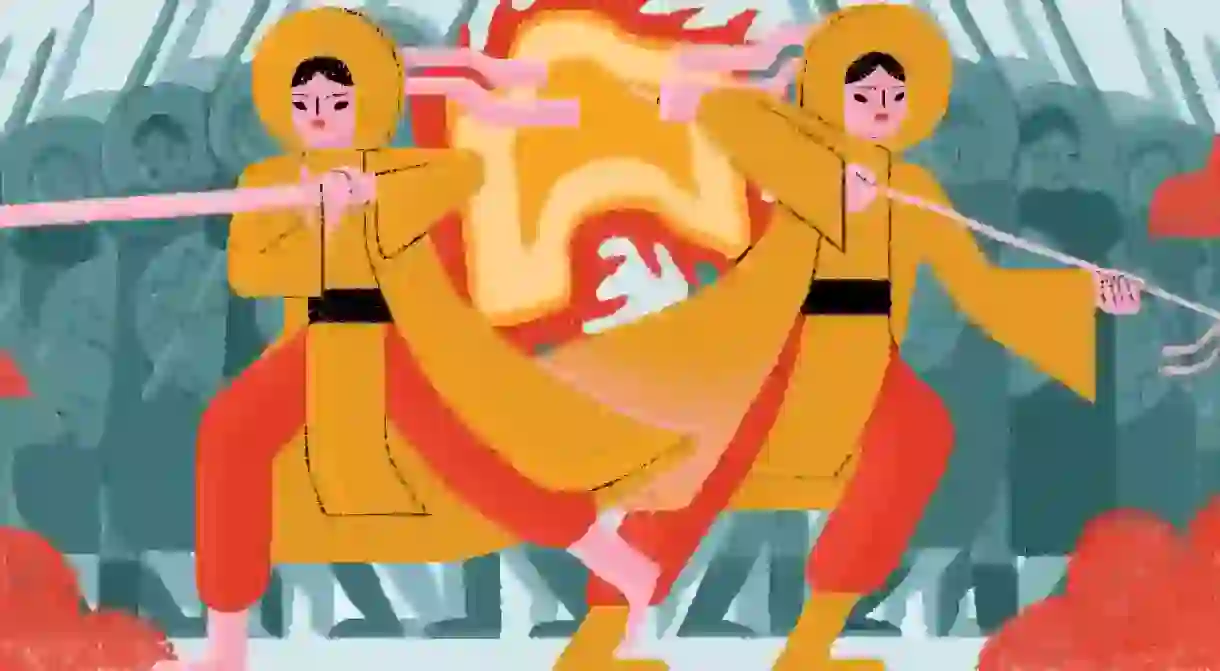Hai Ba Trung: The Story of Vietnam's Elephant-Riding Warrior Princesses

On a busy central district in Hanoi, you’ll see street signs laden with the name ‘Hai Ba Trung’. Many schools, and numerous large streets in major cities of Vietnam are also named this way. Recently, during APEC Vietnam 2017, the U.S. President Donald Trump, used the story of Hai Ba Trung for his speech about Vietnamese heroism and independence. So who is Hai Ba Trung – and what is their story?
Hai Ba Trung is actually not one person. Hai Ba Trung literally translated means “the two Trung sisters.” These two sisters, Trung Trac (older) and Trung Nhi (younger) are national war-time heroines of Vietnam. They were born into a military family in rural Northern Vietnam, being exposed to and studying warfare from a young age. They lived in a time when Vietnamese women were able to inherit property, become political leaders, judges, traders and warriors. These freedoms were removed in later centuries.

With time, the Trung sisters ended up being the very first women in the country’s history to have had become military leaders of the old Nam Viet (Vietnam was called Nam Viet 2000 years ago). In 40AD, after leading a rebellion in their village, they managed to raise an army consisting mostly of women, and led a rebellion against the first Chinese domination of the country. Their army reclaimed 65 citadels from Chinese rule, won the war, and went on to rule the country for 3 years.
Chinese feudal groups invaded Nam Viet and annexed the country in 111BC, dividing the country into smaller districts for easy management. The general of each district answered directly to Chinese governor To Dinh, The Vietnamese suffered greatly under his harsh rule – they were suppressed, exploited and those who resisted were executed. Many of the puppet-generals tried to fight against this and the general of Giao Chi district, happened to be the father of the Trung sisters. When their father passed away, the sisters replaced him and along with the older sister Trung Trac’s husband, another powerful general Thi Sach, they united the Vietnamese generals to revolt against the Chinese. An army of 80,000 people were gathered to help drive the Chinese away from their lands.
Despite Trung Nhi proving herself to be the better warrior, Trung Trac, due to her brave and fearless disposition was proclaimed to be the new ruler. She was renamed “Trung Vuong”, or “She-king Trung.” As queen, she abolished tax policies imposed by the Chinese that were unfair to the Vietnamese. She also attempted to restore a simpler form of government, more in line with traditional Vietnamese values.

Even if the sisters’ rule lasted for only 3 years (they were defeated under Chinese Emperor Ma Yuan in 43AD), the rebellion against the Chinese changed the fate of Vietnam forever. Even if it was a moment’s glimpse in time, it allowed the country to claim back their independent and sovereign rights. This was rare in Vietnam’s largely dominated history. Some even feel that if the sisters had not resisted the Chinese when they did, there would be no Vietnamese nation today. What’s even more, is that this big movement was led by two women, a nod to the fact that the Vietnamese society was once matriarchal, where women could assume leadership roles. This victory also inspired later resistance movements, to fight for the independence of the country, and gave people much-needed hope.

Over time, the Trung sisters became stuff of legends. Plenty of poems, stories, plays came about of them, and they are a source of pride and hope for women who live more restricted lives. Hanoi has a whole district called Hai Ba Trung. One of the longest streets in Saigon is also called Hai Ba Trung. A dozen schools across Vietnam are named Hai Ba Trung. And then there are the monuments that have been erected to glorify the heroism of the sisters. If you see paintings or statues of two women riding giant war elephants, now you will be able to recognize the Trung sisters. It should come as no surprise to you why the U.S. President Trump used the story of the Trung sisters in his speech about Vietnamese heroism and independence, during his APEC visit in 2017. The Trung sisters will forever remain a symbol of national pride to the Vietnamese.













